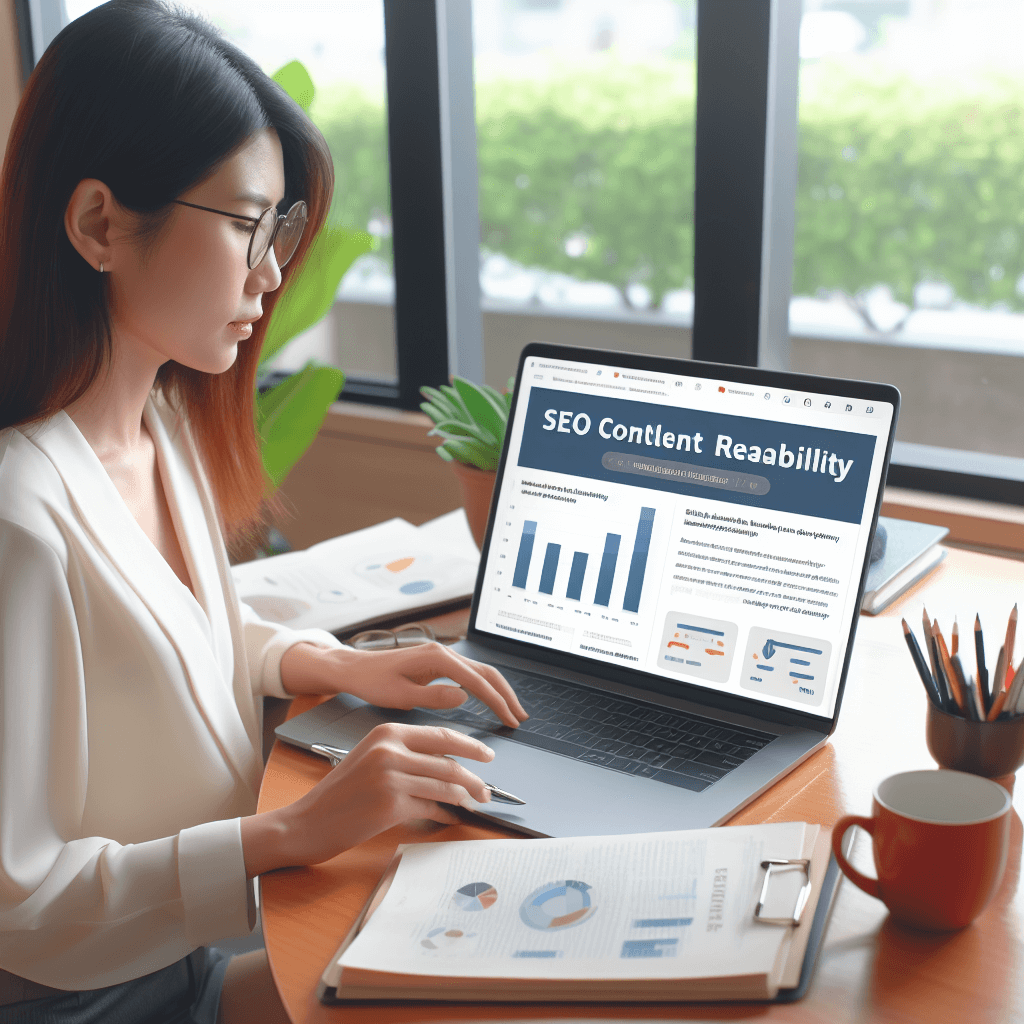Website enhanced readability is crucial for creating a positive user experience and improving SEO rankings. When visitors land on a website, they expect to easily navigate through its pages and understand the information presented. The readability of a website plays a significant role in ensuring that users can quickly comprehend the content and find what they are looking for.
The impact of readability on SEO cannot be ignored either. Search engines prioritize websites that provide a seamless browsing experience, including easy-to-read text. By optimizing the contrast between text and background, organizing sections and pages effectively, and using clear language, you can enhance your website’s readability.
We will discuss techniques such as using white backgrounds, providing concise information, and employing visual aids to help visitors absorb your message effortlessly.
The Significance of Readability on Websites
Understanding Readability for Enhanced User Experience
Readability plays a crucial role in ensuring a positive user experience on websites. It refers to the ease with which visitors can comprehend and engage with the content presented to them. When web content is readable, it becomes more accessible to a wider audience, making it easier for users to navigate and understand the information provided.
Several factors influence the readability of a website. These include the use of clear and concise language, appropriate font styles and sizes, proper spacing between lines and paragraphs, and effective organization of content. By considering these factors, website owners can create an environment that encourages users to stay longer on their site and explore further.
Improved readability leads to better user engagement. When visitors find it effortless to read and understand the content on a website, they are more likely to stay engaged with it. This engagement can manifest in various ways such as increased time spent on the site, lower bounce rates (the percentage of visitors who leave after viewing only one page), higher click-through rates on internal links, and ultimately improved conversion rates.
Key Steps to Test and Improve Readability
To assess the readability of web content, there are several tools and methods available. These tools analyze factors like sentence structure, word complexity, reading level, and overall clarity. Some popular readability assessment tools include Flesch-Kincaid Grade Level test, Gunning Fog Index test, Coleman-Liau Index test, among others. By utilizing these tools regularly, website owners can identify areas that need improvement in terms of readability.
Simplifying complex sentences is another technique that enhances readability. Breaking down lengthy sentences into shorter ones helps readers absorb information more easily. Using simple words instead of jargon or technical terms can make content more accessible to a broader audience.
Strategies for enhancing overall reading experience on websites involve employing visual aids such as headings, subheadings, bullet points, and numbered lists. These elements help to break up the text and make it more scannable. Incorporating white space between paragraphs and using appropriate font styles and sizes can significantly improve readability.
The Impact of Readability on User Engagement
High readability encourages users to stay longer on a website. When visitors find content easy to read and understand, they are more likely to explore further pages, increasing their overall engagement with the site. This extended time spent on the website allows users to delve deeper into the provided information, potentially leading them towards taking desired actions such as making a purchase or signing up for a newsletter.
Readability also influences bounce rates and conversion rates.
Elevate your content’s allure—reach out to Kha Creation and enhance your readability today!
SEO Content Writing and Readability

Crafting Engaging Headings for SEO
Catchy headings are essential for attracting readers and improving search engine optimization (SEO). Incorporating relevant keywords into your headings is a key aspect of SEO best practices. To create compelling headings, there are a few techniques you can employ.
Firstly, using powerful and descriptive words in your headings is crucial. Opt for words that evoke curiosity or emotion to entice readers to click on your content. For instance, instead of a generic heading like “Tips for Healthy Eating,” try something more engaging such as “Discover the Secrets to a Healthier Lifestyle.” This approach sparks the reader’s interest and encourages them to continue reading.
Secondly, it is important to include relevant keywords in your headings while maintaining clarity. Keywords help search engines understand the content and improve its visibility in search results. However, avoid overstuffing your headings with keywords, as this can make them seem unnatural or confusing. Strive for a balance between incorporating keywords and maintaining readability.
Utilizing Strategic Heading Tags for Clarity
Heading tags (H1-H6) play a vital role in organizing the hierarchy of your content and improving its overall clarity. When properly utilized, these tags enhance scannability and comprehension for both readers and search engines.
Start by using an H1 tag for your main heading or title. This tag should accurately summarize the primary topic of your page or article. It provides a clear signal to search engines about the main focus of your content.
Subheadings within your content should be marked with H2 tags. These subheadings break down different sections or topics within your article, making it easier for readers to navigate through the information.
For further organization within subsections, use H3 tags. These tags help create a logical flow and highlight key points within each section. By utilizing H3 tags effectively, you can improve the scannability of your content and make it easier for readers to find the information they are looking for.
Design Elements That Boost Readability

Typography and Legibility Tips
Choosing appropriate fonts and font sizes is crucial for enhancing website readability. Opt for fonts that are easy to read, such as Arial, Helvetica, or Times New Roman. Consider the font size to ensure optimal legibility; a font size of 16 pixels or higher is recommended.
The style of the chosen font also plays a role in reading ease. Fonts with clean lines and simple shapes tend to be more readable than those with intricate details. Avoid using decorative fonts that may hinder readability.
In today’s mobile-centric world, it’s essential to consider mobile-friendly typography. Ensure that the chosen font scales well across different devices and screen sizes. Test your website on various mobile devices to guarantee readability on smaller screens.
Incorporating Whitespace and Visual Appeal
Whitespace, also known as negative space, refers to the empty areas between elements on a webpage. Utilizing whitespace effectively can significantly improve visual flow and reduce cognitive load for readers.
By incorporating ample whitespace around text blocks, paragraphs, headings, and images, you can create a visually appealing layout that enhances readability. Whitespace provides breathing room for readers’ eyes and helps them focus on the content without feeling overwhelmed by cluttered visuals.
Finding the right balance between text and whitespace is key. Too much whitespace might make your page look sparse or incomplete, while too little can make it feel cramped. Strive for an optimal text-to-whitespace ratio that creates a harmonious reading experience.
Using Images to Complement Text
Images play an important role in supporting textual information on websites. They not only capture attention but also enhance understanding by providing visual cues and context.
When selecting images for your website, choose ones that are relevant to the content they accompany. High-quality images that align with your brand’s style will have a greater impact on readers’ comprehension.
Optimizing image placement within your content is crucial. Position images strategically to create a smooth reading experience. Placing images near relevant text can help reinforce the message and improve overall comprehension.
Incorporating these design elements – typography, whitespace, and images – into your website can significantly boost readability. By selecting appropriate fonts, considering legibility on mobile devices, utilizing whitespace effectively, and using complementary images, you can create a visually appealing website that engages readers and enhances their overall reading experience.
Optimizing Content for Better Readability

Simplifying Sentences and Vocabulary
Simplifying sentences and vocabulary plays a crucial role. Long, convoluted sentences can confuse readers and make it difficult for them to grasp the main idea. To simplify complex sentences without losing their meaning, consider breaking them down into shorter sentences. This not only improves comprehension but also makes the content more digestible.
In addition to sentence structure, using plain language and avoiding jargon is essential for better readability. By using simple words and phrases, you ensure that your content is accessible to a wider audience. Consider your target readership and choose vocabulary that resonates with them. Explaining technical terms or industry-specific jargon in simpler language can help readers understand your content more easily.
Concise vocabulary is another aspect that contributes to improved readability. Using unnecessarily long or complicated words can make your content seem dense and intimidating. Instead, opt for shorter synonyms or phrases that convey the same meaning. This allows readers to quickly comprehend the information without getting bogged down by unnecessary complexity.
Enhancing Visual Interest through Design
In addition to simplifying sentences and vocabulary, enhancing visual interest through design is another effective way to improve website readability. Visual elements such as colors, icons, and graphics can significantly enhance engagement and capture readers’ attention.
When designing your website, consider using colors strategically to highlight important information or create visual cues. Colors have a psychological impact on readers’ perception of content, so choose colors that complement your brand identity while ensuring readability remains a priority.
Icons are another visual element that can enhance user experience by providing clear visual representations of actions or concepts. Utilize intuitive icons that guide users through your website effortlessly.
Graphics such as images or infographics break up text-heavy pages and provide additional context visually. They not only make the content more visually appealing but also help convey complex information in a more digestible format. Ensure that the graphics you use are relevant and support your content effectively.
While visual elements are essential for enhancing engagement, it is crucial to strike a balance between design aesthetics and readability considerations. Avoid overwhelming your website with excessive visuals that distract from the main message. Keep in mind that readability should remain at the forefront of your design choices.
Connecting With Your Audience Through Language

Writing in a Conversational Tone
Writing in a conversational tone is an effective way to connect with your audience and enhance the readability of your website. By adopting a friendly and approachable language style, you can engage readers and make them feel like they are having a conversation with you.
One of the benefits of using a conversational writing style is that it creates a more relatable and personal connection with your audience. It helps to establish trust and build rapport, making readers feel comfortable and more likely to continue reading. When you write conversationally, you remove barriers between you and your readers, allowing them to fully immerse themselves in your content.
To create a friendly tone, consider using everyday language that people can easily understand. Avoid using jargon or complex terminology that might alienate or confuse your audience. Instead, opt for simple words and phrases that resonate with the average person.
Another technique to employ is the use of pronouns such as “you” and “we.” This inclusive language makes readers feel involved and part of the conversation. Incorporating rhetorical questions can further engage readers by encouraging them to think about their own experiences or opinions on the topic at hand.
Let’s look at an example to see how effective conversational language can be:
- Traditional: Our company provides top-notch customer service.
- Conversational: At our company, we pride ourselves on delivering exceptional customer service just for you.
- The conversational version not only highlights the focus on personalized service but also creates a warmer tone that resonates better with readers.
Tailoring Language to Audience Needs
Understanding your target audience’s language proficiency is crucial when tailoring your content for enhanced readability. Different demographics may have varying levels of familiarity with certain terms or concepts, so it’s essential to adapt accordingly.
Start by researching your target audience’s demographics such as age group, education level, interests, and cultural background. This information will help you determine the appropriate language style and tone to use. For example, if your audience consists of teenagers, you may want to incorporate more informal language and slang that they can relate to.
Personalization is another effective technique for connecting with specific user groups. By using language that speaks directly to their interests, challenges, or aspirations, you can create a stronger bond with your audience. Address their pain points and provide solutions in a way that resonates with them on a personal level.
For instance, if you are targeting busy professionals looking for time-saving tips:
- Generic: “Here are some time-saving techniques.”
- Personalized: “Are you struggling to find enough hours in the day? Discover these quick and efficient time-saving hacks just for busy professionals like yourself.
Structuring Your Content for Scannability
Improving Sentence Structure and Paragraphs
Constructing clear and concise sentences is essential for enhancing the readability of your website content. To achieve this, follow these guidelines:
- Keep sentences short and to the point. Long, convoluted sentences can confuse readers and make it difficult for them to grasp your message.
- Use simple language and avoid jargon or technical terms that may alienate your audience.
- Break down complex ideas into smaller, digestible parts. This allows readers to absorb information more easily.
In addition to improving sentence structure, it’s crucial to consider the length of your paragraphs. Lengthy paragraphs can overwhelm readers, causing them to lose interest or struggle with comprehension. Here are techniques to break down paragraphs:
- Divide lengthy paragraphs into shorter ones, each focusing on a specific idea or concept.
- Utilize subheadings within your content to create visual breaks and guide readers through different sections.
- Incorporate bullet points or numbered lists when presenting multiple related points or steps.
By implementing these strategies, you can enhance the flow and readability of your content while ensuring that readers can easily navigate through it.
Creating Multiple Entry Points for Readers
Providing various entry points within web content is crucial for capturing the attention of different types of readers and catering to their preferences. Here’s why multiple entry points matter:
- Subheadings act as signposts that allow readers to quickly scan through your content and find the information they need without having to read every word.
- Bullet points help condense key information into bite-sized chunks, making it easier for readers to absorb important details at a glance.
- Summaries at the beginning or end of sections provide a quick overview of what will be covered, allowing readers to decide if they want to delve deeper.
Multiple entry points not only improve accessibility but also enhance user experience by accommodating different reading styles and preferences. They enable readers to find what they’re looking for efficiently, whether they prefer skimming or diving deep into the content.
Assessing Your Website’s Readability
To ensure that your website is easily understandable and engaging for visitors, it is crucial to assess its readability. By employing quantitative methods and effective communication strategies, you can enhance the readability of your web pages and optimize the user experience.
Quantitative Methods for Readability Assessment
One way to evaluate the readability of your website content is through quantitative metrics. These metrics provide objective measurements that help determine how easy or difficult it is for readers to comprehend your text. Two commonly used tools for this purpose are the Flesch-Kincaid Grade Level and Gunning Fog Index.
The Flesch-Kincaid Grade Level measures the approximate grade level required to understand a piece of text. It considers factors such as sentence length and average syllables per word. The lower the grade level score, the easier it is for readers to comprehend. On the other hand, the Gunning Fog Index calculates the years of formal education needed to understand a particular text. A lower index indicates better readability.
Interpreting these readability scores allows you to identify areas where improvements can be made in your website content. By aiming for a lower grade level or fog index score, you can make your text more accessible and engaging for a wider range of readers.
Ensuring Comprehension through Effective Communication
While quantitative methods provide valuable insights into readability, effective communication strategies play a vital role in ensuring comprehension among website visitors. Clear communication involves presenting complex ideas in a concise and straightforward manner that can be easily understood by users.
One strategy to achieve this is by using examples, analogies, or visuals that aid comprehension. These visual aids help break down complex concepts into simpler terms, making it easier for users to grasp information quickly. For instance, if you are explaining a technical process on your website, consider including diagrams or step-by-step illustrations to guide users through each stage.
Another way to enhance comprehension is by encouraging feedback or questions from users. By providing a platform for users to ask clarifying questions or leave comments, you create an opportunity for engagement and ensure that your content is meeting their needs. This feedback can also help you identify areas where further explanation or improvement may be necessary.
Tips for Enhanced Readability
There are several key factors to consider.
Choosing the Right Typography
The choice of fonts plays a crucial role in determining the readability and accessibility of your website. When selecting fonts for your web content, consider factors such as legibility, simplicity, and compatibility across different devices and browsers. Opt for fonts that are easy to read even at smaller sizes and ensure they maintain their clarity on various screens.
Font characteristics like size, spacing, and line height also impact readability. It is essential to strike a balance between these elements to provide a comfortable reading experience for your users. Avoid using overly decorative or complex fonts as they can hinder legibility.
Best practices for font pairing and consistency involve selecting complementary typefaces that work well together while maintaining a consistent visual identity throughout your website. Pairing fonts with distinct characteristics can create contrast and make important information stand out.
Tips for Effective Font Usage
To further enhance the readability of your web content, consider implementing these tips:
- Font Weight: Choose appropriate font weights to emphasize headings or important text without compromising legibility. Using bold or italic styles sparingly can help guide readers’ attention.
- Spacing: Pay attention to letter spacing (tracking) and word spacing (kerning). Adequate spacing between characters contributes to better legibility by preventing letters from blending together.
- Line Height: Adjusting line height (leading) can significantly impact readability. Sufficient space between lines prevents overcrowding of text and makes it easier for readers to follow along.
Following accessibility guidelines is crucial when choosing web-safe fonts. Ensure that the selected fonts are accessible to individuals with visual impairments or other disabilities by providing alternatives such as larger font sizes or high-contrast options.
By implementing these tips, you can significantly improve the readability of your website. Remember that enhancing readability goes beyond just selecting the right fonts; it also involves optimizing other design elements such as color contrast, layout, and content organization.
Let Kha Creation amplify your message—contact us to unlock enhanced readability for your content!
The Consequences of Ignoring Readability

Disadvantages of Poor Readability
Poor readability on a website can have significant negative consequences for user experience. When content is difficult to read and understand, visitors are more likely to become frustrated and leave the site quickly. This high bounce rate not only indicates a lack of engagement but also affects the overall performance of the website.
Poor readability can lead to a decrease in the time users spend on the site. If visitors find it challenging to comprehend the information presented, they are less likely to stay and explore further. This reduced engagement can impact metrics such as average session duration and pages per session.
Furthermore, low readability can have an adverse effect on conversion rates. When users struggle to grasp the message or purpose of a website due to complex language or formatting issues, they are less likely to take desired actions such as making a purchase or filling out a form. In essence, poor readability hinders effective communication with potential customers and inhibits conversions.
To better understand these consequences, let’s consider some examples. Imagine visiting a website that uses tiny font sizes, long paragraphs without breaks, and dense technical jargon without any explanations. It becomes overwhelming and frustrating for users who may quickly abandon the site in search of one that offers clearer and more accessible content.
Another example is encountering poorly organized content with inconsistent headings and subheadings. Without clear structure and hierarchy, readers may struggle to navigate through the information effectively, leading them to lose interest or miss crucial details.
Setting Target Readability Levels for Websites
Defining target readability levels based on your audience is crucial for creating engaging content that resonates with your readers. A key aspect is understanding your target audience’s reading abilities and preferences.
Guidelines exist for determining appropriate reading difficulty levels based on factors such as grade level or age group. By considering these guidelines alongside your specific audience characteristics, you can tailor your content accordingly.
Adjusting content to meet desired readability goals involves various strategies. One approach is simplifying sentence structures and vocabulary to make the text more accessible. Breaking down complex ideas into bite-sized, easily digestible pieces can also enhance comprehension.
Another effective strategy is incorporating visual elements such as bullet points, numbered lists, and subheadings. These elements help break up the text, making it easier for readers to scan and locate relevant information quickly.
Conclusion
In today’s fast-paced digital world, enhancing the readability of your website is crucial. It not only improves user experience but also boosts your search engine rankings. By focusing on elements such as content structure, language, and design, you can create a website that captivates and engages your audience. Remember, the goal is to make it easy for visitors to consume and understand your content.
So, take a step back and assess your website’s readability. Is it clear and concise? Does it flow smoothly? Are you effectively connecting with your audience? By implementing the tips and strategies discussed in this article, you can optimize your website for enhanced readability and make a lasting impact on your readers. Don’t underestimate the power of readability – it can be the difference between a visitor who quickly leaves and one who becomes a loyal customer.


